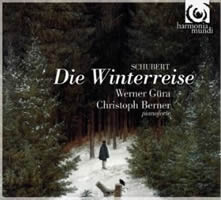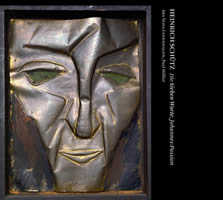Misdelivered
|
Walt Mundkowsky [July 2010.]
Franz SCHUBERT: Die Winterreise, D. 911 (1827) (rec. 2009). Werner Güra (ten), Christoph Berner (1872 Rönisch pianoforte). Harmonia Mundi HMC 902066 (http://www.harmoniamundi.com/). A Winterreise with tenor and period piano arouses my interest (hinting at Schubert’s own recital for his friends?). The opener, “Gute Nacht,” tells me I don’t belong — extroverted (okay, pushy), more petulant than tragic. Snarling Krähe! (“Die Krähe”) is easily the low point, but overly emphatic touches abound. When Güra abates, the result can be beautiful and moving, in “Der Lindenbaum” and the last four songs. “Mut!” is sensationally caught (its swagger makes the disc a keeper) and a stop-and-go “Der Leiermann” holds one in its icy grip. The Brahms-era pianoforte makes no sense, except to separate this CD from 102 (and counting) other Winterreisen on the market. Berner improves en route, as the hero’s lot becomes more desperate. Haefliger / Dähler (Claves, 1980) and Prégardien / Staier (Teldec, 1996) still trouble me, as do Schäfer / Schneider (Onyx, 2003) in unique fashion.
Heinrich SCHÜTZ: Die Sieben Worte, SWV 478 (bef. 1658)1; Johannes-Passion, SWV 481 (1666)2. Else Torp1 (sop), Linnéa Lomholt1 (alt), Adam Riis1, 2, Johan Linderoth1 (ten), Jacob Bloch Jespersen1, 2 (bs), Juliane Laake1, Sarah Perl1 (gambas), Eric Lindblom1, Erik Björkqvist1, Ian Price1 (sackbutts), Allan Rasmussen1 (org), Ars Nova Copenhagen1, 2, Paul Hillier1, 2 (cond.). Dacapo 8.226093 (http://www.dacapo-records.dk/). Distributed in the US by Naxos (http://www.naxos.com/). Hillier’s Schütz cycle reaches Vol. 3: Nothing goes seriously wrong, and yet, and yet. Die Sieben Worte has intense focus without the austerity of his late works. His mature style is fully evident, and a Symphonia counts as his sole surviving instrumental piece. A broken consort — early trombones and viols — plays it here; I’d rather hear the definition a body of strings provides (Helbich, Naxos, 2001). Long reverb at Garnisonskirken, Copenhagen and Hillier’s sluggish pace could be related (“like green apples and stomach-ache,” to cite Philip Larkin). Helbich’s is finer throughout, but its 17:18 timing (2:29 quicker) affords a rhythmic snap and urgency that are a world away. Johannes-Passion is the last of Schütz’s three Passions. They follow a Dresden tradition, but the basic format goes back to the Renaissance — large rôles for Evangelist and Jesus, with choir members filling smaller parts and crowd scenes. (No instruments were allowed in church music for Lent.) The (very) slow tread is more effective here, leaving Riis room to mold the narrator’s many lines. (A faux pas: He and the tenor Pilate sound virtually the same.) Jespersen’s Jesus is dully sonorous. I grew up on Ehmann’s 1961 Cantate version and it remains credible. It takes 32:42, against Hillier’s 38:10. Hillier made a splendid recording of Lassus’ St. Matthew Passion (1575) in 1993. It lives on in an HM “1+1” budget double (minus the original’s deluxe package), and occasioned this article.
[More Walt Mundkowsky]
[Previous Article:
Piano Factory 6.]
[Next Article:
Christian Marclay at the Whitney]
|

